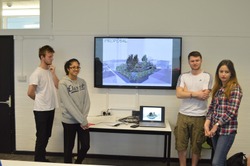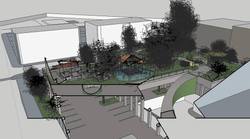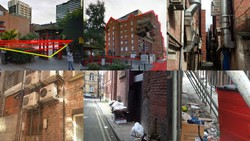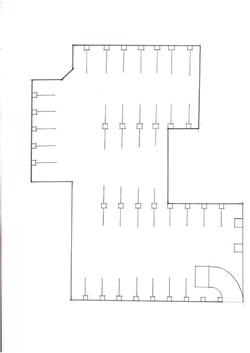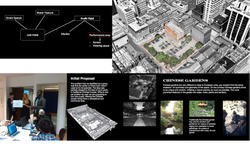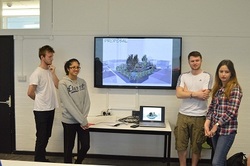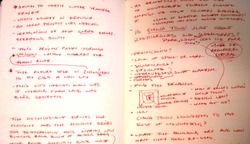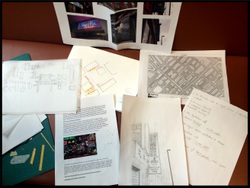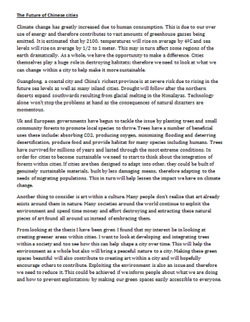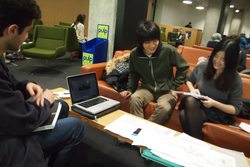At the final presentation, we had the opportunity to receive feedback from Mr. Edward Fox and Dr. David Haley. I found the event to be very interesting and challenging. We managed to identify issues in China Town and learned how to design in order to solve them.
Posted 18 May 2014 23:36
After presenting our idea to the 5th year mentors and receiving the feedback, we came out with a design and made a sketch up model of it. After the second review, we made small changes to the design, according to the suggestions we received (adding trees to exaggerate the vertical aspects of the park, voids to bring light into the dark car park space below, and correctly managing water drainage).
Posted 18 May 2014 23:20
Sketch up section of the proposition, including ramp.
Posted 18 May 2014 22:50
Sketch up section of the proposal, which shows the leveling. (car park and elevated garden)
Posted 18 May 2014 22:48
While exploring the China Town, we noticed the lack of green spaces and the large amount of food waste from the restaurants. This determined us to propose a way to solve both issues, by building an elevated garden on top of an existing car park, with compost created from the food waste.
Posted 18 May 2014 13:47
This is a sketch of one of the greenhouses, and the compost boxes in front of it. The greenhouses can be used for food growing for restaurants.
Posted 18 May 2014 12:53
This is the plan of the car park, including the ramp for cars.
Posted 18 May 2014 12:44
This is the plan of the elevated garden, including the ramp for people.
Posted 18 May 2014 12:38
Mr. Edward Fox and Dr. David Haley gave us useful suggestions. For the future project development, all the groups could communicate after today's presentation, all their works put together could be amazing !
Posted 18 May 2014 11:37
Wonderful presentation of each group.
Posted 18 May 2014 11:33
Essay about China's urbanization and urban planning
Posted 18 May 2014 03:45
The presentation was successful. The feedback we got included we needed more research into Chinatown and more grounding in reality. however overall the scheme was successful and enchances the spirit and vibe of Chinatown well.
Posted 17 May 2014 17:58
After collecting all the work from everyone and combing it with mine I put together a powerpoint presentation, to which we made some adjustments as a group and then went on to presenting on the final day of the event.
Posted 17 May 2014 08:27
Finalised visual proposal for the car park in China town.
Posted 17 May 2014 08:12
A few days after we met as a group we had a brief tutorial meeting with the tutors about our proposal for China town. We shared our ideas with them and got some constructive feedback, and then we went on doing our share of the work.
Posted 17 May 2014 08:04
As a group we identified the problem that the centre of China town was being wasted as a car park and thought we could turn it into something more productive. Since the centre lacks green spaces we propose to transform the car park into a park, offering the Chinese society living there a recreational and communal area.
Posted 17 May 2014 07:46
On the first day of the event we had a lecture by Dr. Haley after which we overviewed a few of his Chinese student's presentations on future living in China. Afterwards we were split into groups and went on to doing some field research. After identifying a few problems, we had to think of a proposition for future China town.
Posted 17 May 2014 07:32
The concept of new urbanism and how it applies to China.
Posted 17 May 2014 07:00
We presented our project and got feedback from Edward Fox and Dr. David Haley.
Posted 17 May 2014 02:51
I was assigned the task of making the technical drawings for the project. I started by drawing the context and then our vision in plan and section on AUTOCAD. Then I further edited them in photoshop.
Posted 17 May 2014 02:34
My personal re-visit to the site helped me further appreciate the site when it comes to scale and further site analysis
Posted 17 May 2014 02:26
My Group chose the car park as our primary site. We felt it was not used to its maximum potential as a car park and quite frankly wasn't needed at all. We decided to turn its function to that of a park that serves the surrounding businesses, kind of like a centre within the centre of manchester.
We also looked precedents to aid our design process.
Posted 17 May 2014 02:15
Site Visit: China Town, Manchester.
After getting spilt into four groups, we ventured out into chinatown to observe the area. Restaurants, Massage parlours, nail and hair salons and night clubs were the most prominent features of the area.
Posted 17 May 2014 01:39

An Essay on Chinese Cities
When we look at China, it is impossible not to notice the urbanization of the nations cities. “Just over 680 million now live in cities – 51.27 per cent of China's entire population of nearly 1.35 billion.” (Telegraph, 2012)
The majority of this move has happened in the past two decades as a result of the response to the boom in economic opportunities. People seeking for better job opportunities and higher pay; the migration from fields and modest homes to office and high rise apartment blocks. This is similar to that of Manchester, in the 1800s. A period marked for the rise of the Industrial Revolution. Large numbers of people migrated to Manchester for the hope of better life, better jobs, but the reality of the situation was different: bad and expensive accommodation, houses with no heating, poor hygienic environment; all in all very poor standards of living. China on the other hand is dealing with the problems that urbanization causes. There have been a massive drive to provide good housing, health and education facilities in the cities. However, the rapid modernization and demand for improved living standards is pilling extra pressure on the society and the already blighted environment. Many of those settling down in urban areas are migrant workers – people moving from the country to cities to seek economic empowerment.
This transient population of cheap labour, put at nearly 221 million by a national census last April, helped turn China into the world's second-largest economy in just three decades. (Telegraph, 2012)
The influx is seen as having a destabilizing effect on urban society, according to experts. Unfortunately, government policy has not been updated, so migrant workers are still classed as rural residents. The outdated Hukou housing registration system ties migrants to their hometown and this means they only have access to benefits back in their local towns. This brings about very little to no social security and results in most migrant workers being treated as lower-class citizens.
Along with urbanization comes the process of gentrification.
Gentrification is a shift in an urban community toward wealthier residents and/or businesses and increasing property values. Gentrification typically occurs when the government open up the ties with private companies to help spur economic development and attract business all with the aim of tackling urbanization.
The negative effect of this is that a lot of migrant workers are forced to stay in the cities even with very poor wages and standard of living because their farms have been taken from them by land grab schemes. These large corporations are merciless in the execution of their schemes, they capture land owned by the farmers and build insensitive structures therefore displacing the original tenants.
Another effect of urbanization is climate change. Industries are using more energy and in turn burning fossil fuels. It is estimated that in 50 to 100 years, coastal cities will be affected greatly but rise in sea leves including china’s richest province- Guandong.
It seems unrealistic that technology will be able to cope with the sheer danger of climate change. It is anticipated that when south east Asia is affected by changes in sea level for instance, the rich will migrate leaving the poor to face the problems. Its amazing that the capitalist society we live in, the rich create the problem and leave the poor overwhelmed in attempts to solving them.
Images added as part of the essay to illustrate ideas.
Images gotten from :
http://www.scmp.com/sites/default/files/styles/980w/public/2013/11/11/planting.jpg?itok=zRvSJOjm
Posted 17 May 2014 01:16
We present our work to Dr. David Haley and Mr. Edward Fox. Their feedback are very useful. Our design is too geometric. We should design the garden in a more organic layout as most of the Chinese garden are design in that way. We also have a chance to look at work of other group. The presentation of other group are inspiring.
Posted 16 May 2014 18:39
This is the 3D model of our green space. The space is divided into two parts. The left part is the space for screening and the right part is a seating space. The water fountain acts as a separation between two area.
Posted 16 May 2014 17:21
We had presented our idea to our mentor. We discuss about reason of making the park and the difference between Chinese and western gardens. After the discussion and research, we had decide to put a water fountain into the park as it is an important feature for Chinese garden. The picture shows the proposed circulation of the park
Posted 16 May 2014 17:10
We looked at the film Bladerunner and used it as a small case study to see how signage could be installed and depicted in the not too distant future.
Posted 16 May 2014 16:01
This diagram was used to explain how Dual Image Screens function.
A parallax barrier is placed in front of an LED or LCD screen. This barrier blocks half of the pixels on the screen depending on what angle you look at it from. This allows two separate images to be displayed on the screen. One image for the person on the left, one image for the person on the right.
This means that you are able to broadcast twice as many adverts as you could before while still using the same amount of surface area as before
Posted 16 May 2014 15:59
Two black and white images of a street less than 20 metres away from the main heart of Chinatown. The image on the left is the original, while the image on the right shows how adding a few signs using tracing paper can really change the character of a place.
It also allows you to visualise how different the streets around Chinatown really are.
Posted 16 May 2014 15:54
Another sketch showing how adding colour really changes and alters the feel and character of an area.
Posted 16 May 2014 15:50
We had to look at how changes in population would change how people advertise in Chinatown. More people would create a larger audience to advertise a product or service to.
Posted 16 May 2014 15:46
After the research of Feng Shui and Chinese culture,We develop our final idea.At the final day we presented our design ideas through the processes of research and analysis.The master plan of the park shows how these elements connected together and how could be used.Furthermore, we present the section of the plan and the perspectives drawings, which show clearly our park’s design by different angles. Finally, we receive a feedback from Dr H.David and Mr. F.Edward,which tell us the good and bad things for our process and design.
Posted 16 May 2014 12:42
During my trip to Manchester China town, I found some interesting elements .The two entrances, which already exist to the car park are adopt the Chinese traditional architecture.Inspired by this architectural style,I took some photos and I sketch some elements,such us the roof design or the details of the structure.We try to connect these elements of the Chinese architectural style with the philosophy and culture of Chine.Our idea was a combination of these two , philosophy / culture and elements of the traditional Chinese architecture.
Posted 16 May 2014 12:06
We took a group photo after the final presentation on 14 th May 2014. As you can see we are all happy for what we have done and learnt so far and we have become good friends !
Posted 16 May 2014 06:53

Feng Shui is an important tradition in Chinese Architecture. It has a close relationship with the five elements and the Bagua, the metal, the wood, the water, the fire and the earth, which can be represented by the actual element itself or by different colours.
At the centre, it represents the chi circulation, which symbolizes health. At the North, there is fire which can be represent by red and symbolizes the future.At the south, it has water, blue in colour , which symbolizes your career. At the west, we have wood and earth, which are represent green and brown, symbolizes the wealth and wisdom of a person perspectively. In the east, we have metal, which symbolize a good relationship with fellow people, and it is in grey colour.
In our garden design, we try to cope with the idea in order to have a good feng shui. We have a large red wall with yacht drawing on the north, we put metal (Rocks) in the east, And water surrounding the central pavillion, circulating around it. We have wooden cantilevered platforms, ginkgo trees and bamboos in the west side of it.
Aside from that, we decided to keep the car park, inwhich we can allow the restaurant owners to park their luxury cars and show their wealth!
Posted 16 May 2014 06:50
A Perspective of the new garden was done on 12 th May 2014. The centre Pavilion, the side wooden corridor and the cobblestone road is captured in the perspective, designing under a traditional Chinese style.
Posted 16 May 2014 06:40

Water services are often expensive and not easy to maintain.We have confirmed that there is a water supply pipeline system neat the Faulkner street, so the water supply for the fish pond is not a problem.
However, water features are expensive for maintenance and they cost problems when it is not running. For example, if people lit on it and rubbish would cause hygienic problems and bad smells, which is highly to happen near the restaurants.
Apart from that, running water is also less likely to freeze in winter as the water particles are more dynamic.
In order to lessen the problem, we need to keep it running and select fishes that represents good fortune and live in fresh water Arowana, Flowerhorn and Asian gold fish are some good choices.
It is not easy to keep the water flowing by itself, as this causes energy. Mechanical systems like pumps and jets can be used in keeping the water moving. Grass and vegetation can be planted at the sides of the pond to prevent soil erosion from happening. This can lessen the effect of evaporation on the pond and prevent it from drying. Water can be directed by an underground piping system, to the bottom of the fish pond,to keep the water warm enough for the fishes to live in winter, as Manchester has a pretty cold winter. Warm water would rises up to create a convection current in the pond, which also keeps the water circulating.
Posted 16 May 2014 06:27
Group 1 discussing the layout of the park on 7th May 2014. At first, we suggested to build a fish pond at the centre of the garden, where water symbolizes life, and it is important in a Chinese garden.
Posted 16 May 2014 06:25
China Town is located at the centre of Manchester. After a site visit, my group agreed that the major problem of the site is the car park at centre. It has some Chinese features, for example the wall linings, the two pavilions and the pai fung, but they are not very well organized. The circulation of the area is unclear and the space is not well defined. We decided to keep 10 cars parking spaces, and change the car park into a green space, a Chinese Garden, right in the centre of the city, as a landmark and a place that locals and visitors can relax and experience the mix culture of Chinese and British.
Posted 16 May 2014 05:32
In Feng Shui, a house is like a human body. Designing a house is like building up a healthy body. The rooms are like our organs, which serves different functions. The circulations are like our blood vessels, which links the organs and carry blood and nutrition to feed the organs. When everything is in harmony with nature, we are going to stay healthy and happy living in the house.
Posted 16 May 2014 04:21
Before the start of this event, we were told to read 5 essay about urbanism, global warming and fresh water issues in the world. As I am from Hong Kong, there is one essay that particular interests me. It stated that Hong Kong would be reclaimed by the ocean in 2048, That is quite alarming, however, I do not believe that we can turn the tide of global warming anymore without significant technological advancement. As well as we are still living in the cities, we cannot avoid urbanism. It is not only an environmental issue, it is also an economic development process. We cannot reverse the process anymore, but we still can act immediately to slower the effect, in order to have more time for our scientist and engineers to solve the problem.
Posted 16 May 2014 03:19
Throughout the whole event, my interest in urbanism in emerging Asian countries becomes by far deeper than even before. The development process with ignorance of urban regulations would make the cityscape even chaotic, which in fact positively serves as an invigoration of the site. This paradox would be a new crucial urban topic in the 21st century being pretty worth examining.
Posted 16 May 2014 02:38
Group Photo Event 17! Thank you very much, everybody! I really enjoyed it!
Posted 16 May 2014 02:16
Mr. Edward Fox (senior lecture in MSA landscape department) was also willingly to join in our final presentation session. As well as David, he gave us beneficially intellectual feedback, especially in terms of his expertise: Landscape. We really appreciate his passionate commitment to our project as a professional.
Posted 16 May 2014 02:12
Dr. David Haley gave critical comments on each group project. His feedback again widen our perspectives toward Asian urbanism, architecture and landscape design in addition to the prior introductory lecture fortnight ago. We really appreciate his collaboration as a project adviser!
Posted 16 May 2014 02:04
A Final Presentation was done, explaining in detail what the project is and how it works, and also how we came to our decisions to panelist who gave feedback
Posted 16 May 2014 01:55
After the designs where made for the final idea, 5th year mentors gave advice on the improvements that could be done to maintain the design appropriately.
Posted 16 May 2014 01:52
David Hanley's presentation provided us with many information on the likes of how people live and how they go about in their own lives. He used many interesting research which was carried out by his Chinese students back in china, looking at the present day problems of urbanism. When investigating Manchester's China Town, and refering back to David Hanly's presentation I saw many things which he talked about in the presentation. The likes of modern day influences overpowering the cultural, the traditional aspects of China town. This image shows some of the few traditional Chinese architecture, but there where a minute number of this.
Posted 16 May 2014 01:42
After our visit to China town, we came up with ideas for our design prospect.
Posted 16 May 2014 00:07
And in the final day we presented our design ideas to the whole group,our 5th year coordinators,David and Eddy.It was very interesting watching presentations from the other groups as well because we all had to design with the same aim but every group chose a different aspect to develop and change for the future of China town.Designing a site considering the character that it creates and especially when it has to do with a whole new culture was a very useful aspect that events tought us to consider from now on this year.In the picture you can see our final masterplan with a section through the middle of it which was part of our final outputs for the event.
Posted 15 May 2014 23:40
After our research on Chinese culture and the Feng Shui,we started investigating ways of interpreting these elements with our site in China town.The picture shows a sketch that we produced in that stage of the design.It is actually showing how could we use these elements in the car park site of China town in order to give it the character as well as the function that we needed.
Posted 15 May 2014 23:29
In the event program we went to the present China town of Manchester to identify the elements of surprise and that of course were the amount of food waste along the side street of the restaurants. Our objectives in this event was to come up with a solution to fix this problem and that was to create a waste deposit garden, using waste to create compost so local restaurants use this facility to grow food themselves .
Posted 15 May 2014 23:11
That was one of the preliminary stages of our design development.Research about Chinese culture and philosophy as well as Feng Shui were our inspiration for creating our design for China town in Manchester.
Posted 15 May 2014 21:16
On our final presentation our group have received some inspirational feedback from David and Eddie. Definitely worth exploring on the effect of neon signs/light signs in a wider scale of Manchester in the future. It was also interesting listening to other groups' presentation as their proposition/interest in the topic is so different to ours.
Posted 15 May 2014 20:14
The final presentation was essential as it gave us a opportunity to receive crucial feedback which was given by the event leaders, David and Ed.
I found the whole event advantageous as it made me look how to design in a different way. Looking at ecological values and how we can improve them within architecture. Revolving the project around China Town brings culture into the concept also and is a great space in the city to study. In all an interesting event.
Posted 15 May 2014 17:33
13/05/2014
With the feedback the group and I went away and drew up the developed design. The comments from the event leaders was valuable and helped us understand China Town more.
Posted 15 May 2014 15:06
08/05/2014
With our idea in mind and a short amount of time we started to build a 3D model to easily convey our ideas.
Taking this proposal and our idea to tutorials we received great feedback with how to improve our design and to show more of our research to back up our concept
Posted 15 May 2014 15:01
06/05/2014 Presentation & Field Survey
David Hainley gave a presentation on the research him and his student from China had found. In all the research was about the effects of climate change upon China. Ways that the Chinese government tried to withstand climate change were impressive.
During the field survey I tried to take inspiration from the presentation and try and improve China Town in an ecological way. Admiring the restaurants and shops I noticed back streets that were full of litter. I noticed it was mainly food waist. Which can lead to rats. Therefore my group and I came up with a proposal of using the waste food as compost to create a park and soil to plant.
Posted 15 May 2014 14:59
07/05/2014
Between the tutorial and last meet up we started to sketch up our proposal and work out problems with heights, transport of waste, run off etc.
Posted 15 May 2014 14:57
Essay analyzing and looking at the present day issues with china town and the possibility of the future.
Posted 15 May 2014 03:13
A photograph that shows some of the ideas and thoughts we had while deciding what our proposal would be.
The image contains a few sketches, simple site analysis, maps and information on population trends in Chinatown.
Posted 14 May 2014 16:00
We decided that our proposal would revolve around signs in Chinatown. These three sketches show an existing sign found outside a small restaurant in the heart of Chinatown.
Posted 14 May 2014 15:43
Short Essay On Urbanism In China
Posted 14 May 2014 15:16
At the next meeting, we start to thinking about the design geometry,materials ,architectural elements and arrangements of the garden, based on the Chinese philosophy and culture. We agreed to connect 3 access points(2 main front entrances and the back one which connect the car park with the garden.The shape of the path was based on Ying & Yang philosophy,which connect a centre temple with the entrances.Fish bones, stones, grass and vegetation are some of the elements, which we are going to use to our project.Tai chi and relax zone will provided to the park.
Posted 14 May 2014 11:56
At the third meeting of our group, we decide to choose the car park site at the centre of Manchester China town.Our project ideas,was to replace the exist car park with a Chinese garden.That place should be a mark for chinese district, which switch the chinese tradition and philosophy to the site.
Posted 14 May 2014 11:21
We amended our design based on the comments we received; adding trees, voids and ponds and a waterfall to account for rainfall. We were thoroughly happy with the end result as it had achieved all that we originally set out to do; provide green spaces within the district as well as cleverly disposing biodegradable waste. here are a few slides from our final presentation
Posted 14 May 2014 01:28
After planning our idea and drafting it, we met with our 5th year mentors to discuss it; they advised us on what could be improved. They suggested we add trees to exaggerate the vertical aspects of the park, as well as voids to bring light into the dark car park space below. we also needed to think about water drainage and how we would correctly manage it
Posted 14 May 2014 01:18
In order to create a functioning green roof we needed to look at existing green roofs. We gathered precedents and noted the structure and materials we would need to use. Here is an example of one of our precedents. This was particularly relevant as crops were grown on this roof; this was similar to our idea of letting restaurants grow their own food on top of the garden to save on delivery costs and CO2 emmisions from delivery trucks
Posted 14 May 2014 01:09
After looking at china town we saw that in the middle was a large car park. our initial idea was to replace the car park with a green space, however this seemed impractical as the car park is a valued space. We therefore decided to elevate a plot of land above the car park. This would give china town a dynamic feel. The elevated green park would be fuelled by the biodegradable waste (I.e left over food) from the restaurants that surround it
Posted 14 May 2014 00:32
after visiting china town we noticed that greenery was sparse and on top of this we saw that waste in china town wasn't being disposed of very well. From our field work we decided that these issues must be addressed. We needed to come up with a way to help clean the streets of china town, whilst also integrating green areas onto the site
Posted 14 May 2014 00:26
Writing a 500 word essay really helped me understand what it was that interested me about climate change and what needs to be done to prevent its negative effects. I particularly enjoyed reading about introducing forests and green spaces to help combat CO2 emmisions
Posted 14 May 2014 00:17
Today we put together our findings and finalised our output for our group's vision and the presentation.
Posted 13 May 2014 23:59
Me and Nico were given feedback and new ideas on how to analyse light signs by the fifth years and are inspired to also look at Tokyo(besides HK) as case study.
Posted 13 May 2014 23:54
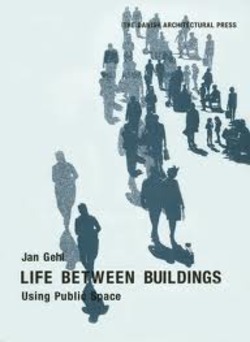
„What makes China Town and What are the most crucial elements for China Town?“
In that essay I would like to discuss the title: What makes China Town? And outline elements which are crucial for the Chinese street view.
Manchester’s Chinatown is located in central area of the city. The boundaries of that area are easy to recognize. The density of chinese shops and restaurants is changing fluently from the Chinese Arch to domestic Manchester sourounding. Visitors can recognize that space because of hudge range of elements, which makes that place has identity.
„The area is compact enough to retain a real sense of community and camaraderie but diverse enough to offer a rich and varied experience. „ Ref. VirtualTurist
If we look back at the Faulkner Street scene we can recognize the Chinese Archways
- the most typical, architectural element which „makes China Town“.
Those beautifule gates has got always two, or more decorative pillars, and roof. That land mark is useful to outline the differences between China Town and the rest of the city. That also shows the pride and wealth of Chinese community.
„In architectural terms, it is important that buildings should promote identity: that is, the individuality of each cityzen. (...) Like individuals cities should have character and flavour, this flavour is made up of numerous chracteristic, or identifable elements.“
ref. [Crosby,1965:16]
In many buildings of China Town - houe, shop, office and workshop areas are mixed. Multifunction spaces and compexity, allow people to live in the China Town and it also make that place unique. Despite the low quality of public space there is a hudge number of outdoor activities. Colorful and dense advertising, bright neons and decorated shops windows can attract people from hudge distant. Streets are not pedistrianize but the movement of cars is low which allow people to cruising around.
Unfortunatelly China Town has not get many resting areas. Local sociecy has not get an opportunity to enjoy summer weather or spend a break between rush hours. There are only seven banks in the nearest suronding of Chinese Arch. Lack of resting places can limit the number of social contacts between cityzens. It can also decrease the numer of turists in that area.
The greenness in China Town is restricted too. Narrow streets and pavings do not allow any space for plants or trees. There is no doubt that planting can improve macroclimate and psyhical health of Chinese people.
Because of cultural meaning and street views China Town is one of the main Manchester’s atractions. Mancunians and turists fom all Europe are comming to taste Chinese cusine or take a look on Chinese Arch. Multistory buildings provides good background for colorful avertisemens and daily life. I am sure that condition of outdoor space depends on proper development in future. I am sure that Manchester’s China Town will be representativ for further generations, like it is today.
BIBLIOGRAPHY
BOOKS:
Crosby, Theo, 1965, Architecture: City Sence, Studio Vista London, New York.
Gehl, Jan, 2011 , Live between buildings, Island Press, London.
ONLINE REFERENCES:
[VirtualTurist, available from:(http://www.virtualtourist.com/travel/Europe/United_Kingdom/England/Greater_Manchester/Manchester-308843/Things_To_Do-Manchester-Chinatown-BR-1.html), accesed on 05/05/14]
Posted 13 May 2014 23:49
We revisited Chinatown at night to take pictures of neon lights when they are turned on and further study on the site regarding light signs.
Posted 13 May 2014 23:43
05/05/2014 Essay
To start the event I was given past lectures surrounding the subject of ecology within China. I was to study these and write a short abstract of what I thought about this notion. The texts given were informative as I did not know China was under such threat and the ways they were dealing with it. I have never solved architectural problems with an ecological technique. Therefore I was looking forward to gaining more information from the presentation and seeing how China Town could be improved.
Posted 13 May 2014 23:08
The final design created in the image shown has been fine tuned since the last review. Trees in the garden are double height stemming from the car park below up above the platform. The Chinese style pavilions are added keeping the local aesthetic in mind.The car park has been left as there is minimal parking space in central manchester so we felt it necessary to keep it instead it has been lowered slightly.
Posted 13 May 2014 22:32
Based on the review with the 5th years, a few minor alterations are needed to the design of the platform. A possible change in levls was suggested with a small hill to make it an bovious place to sit or play for children. Also the colour scheme and how it will sit in with its surroundings is key and it needs to become a part of Chinatown, not stand out like a soar thumb.
Posted 13 May 2014 22:15
Feedback and guide for the further development. All the groups did great jobs so far. All they need to do is visualizing all their information and thoughts into diagrams.
Posted 13 May 2014 22:10
